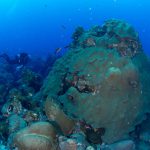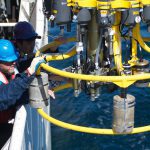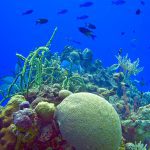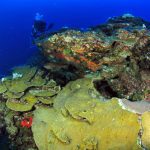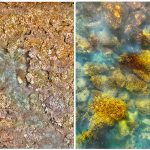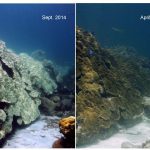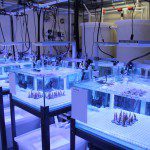New research techniques include genetic sampling to predict coral bleaching
For the third time in recorded history, a massive coral bleaching event is unfolding throughout the world’s oceans, stretching from the Indian Ocean to the Caribbean. Above average sea surface temperatures exacerbated by a strong El Niño could result in the planet losing up to 4,500 square miles of coral this year alone, according to NOAA. The global event is predicted to continue to impact reefs into the spring of 2016.
Across the Caribbean, AOML scientists and their partners are conducting multi-disciplinary research projects to monitor the potential for bleaching, measure specific indicators of coral resilience, and improve bleaching prediction capabilities. This ongoing research encompasses multiple levels of the reef ecosystem, from the community level down to the microorganism level, with the goal of providing predictive insights to inform reef managers and to support coral reef conservation efforts.
Refining the scope of bleaching forecasts
In the Cayman Islands, researchers are measuring water temperatures at a series of depths on coral reefs around Little Cayman to improve water temperature estimates in regional bleaching models. These models currently rely heavily on global satellite measurements of sea surface temperatures, which are used as a proxy to represent temperatures below the surface where corals reside. There is great variability between surface and subsurface water temperatures depending on local oceanographic conditions.
The water temperature data collected from the sites at Little Cayman are being compared to data from a nearby established monitoring buoy to provide more precise temperature comparisons across different reef environments. This insight can be used to refine the scope of NOAA’s bleaching forecasts from region-wide to reef-specific, allowing coral reef managers to better target monitoring and recovery efforts.
Monitoring bleaching impacts along the Florida reef tract
In the Florida Keys, offshore reefs have deteriorated dramatically since the late 1970s, while inshore reefs have remained resilient and continue to maintain high coral cover. Ongoing field studies are leveraging the current bleaching event to determine why inshore reefs appear more resilient. Scientists will continue to monitor the impact of this severe bleaching event to determine the extent of coral mortality and to isolate factors that may serve as indicators for future bleaching events.
Along the Florida reef tract, an AOML research team deployed pH, temperature, and light sensors at coral reef sites both near and offshore to measure the extent of bleaching impacts. Additionally, an AOML partner with the University of Miami’s Rosenstiel School photographed these reefs using a high-resolution camera. By compiling these photographs into mosaic images, researchers can more accurately document community-wide changes in reef health.
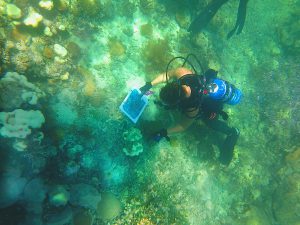
An AOML coral researcher uses a photo mosaic to locate a bleached coral head on a reef in the Florida Keys. Image credit: NOAA
How do Florida reefs compare to other reefs in the region?
Other locally driven stressors to the Florida reef tract, including sediment from coastal construction, pollution from land-based nutrients and fertilizers, physical damage from divers and boaters, and overfishing, all further impact reefs by compounding the stress from global changes, such as warming oceans and ocean acidification. To separate the effects of local anthropogenic stressors from global changes, AOML researchers, along with scientists from the Central Caribbean Marine Institute, are monitoring the pristine reefs found along Little Cayman. Experiments at this site are designed to contrast them with populated coastal reefs and determine why reefs around this remote island are thriving despite widespread bleaching across the region.
What makes Little Cayman’s reefs special?
With an estimated population of only 150 people, Little Cayman lacks a significant human presence. Combined with the island’s relative isolation and protection from overfishing, as well as coastal pollution, coral communities have thrived. Ongoing studies of the reefs surrounding Little Cayman have been designed to document globally-driven changes to the reef ecosystem, from studies of specific species to ecosystem-wide shifts.
Established monitoring sites equipped with data-collecting buoys have provided a baseline of environmental data at key coral reef sites around the island before the most recent mass bleaching. Current studies will observe environmental conditions at Little Cayman, and samples of coral polyp tissue will correlate changes at the organism and microorganism level, with a goal of noting specific changes that allow these corals to become more resilient. The resulting insights could be adapted to help inform protection plans for vulnerable coral reef ecosystems in other parts of the world.
Genetic sampling to predict resilience
At Little Cayman, as well as at sites along the Florida reef tract, researchers are concentrating their efforts at even smaller scales to explain differences in coral susceptibility and resilience to bleaching. With a focus on two species of rare and endangered coral, they are collecting and studying tissue from individual coral polyps. The goal is to identify the genetic makeup of the polyp’s ‘microbiome’, the consortium of algae, bacteria, viruses, and fungi, all living in a dynamic equilibrium with the coral animal. The differences in genetic makeup within these microbiomes can be used as a key indicator of adaptation in specific corals over time. This genetic variability may explain how some corals survive exposure to a variety of stressors, including warmer ocean temperatures.
Can genetic sampling predict a coral’s response to bleaching?
When faced with changing environmental conditions, the microbiome community is the most genetically adaptable part of the coral. A coral’s resilience to ocean warming depends on the combined response of its microbiome. By using next-generation-sequencing of the DNA and RNA associated with these microbiome communities before, during, and after bleaching or coral disease events, researchers hope to identify the genetic traits of the most resilient corals and their microbial communities.
Managers can apply this understanding to monitoring programs, looking for these genetic changes as a predictive marker for potential bleaching. Additionally, acquiring the ability to identify specific microbiome combinations that are more resilient than others may help the efforts of reef-rebuilding organizations as they select species to grow in nurseries and identify reef locations to outplant corals.
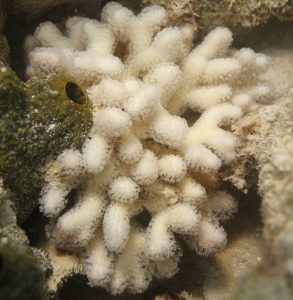
Genetic sampling done by AOML researchers will help reef managers identify coral species that are more resilient to bleaching and other stressors, such as high levels of nutrients. Image credit: NOAA
Coupling insights on the diversity of corals and their microbes with bleaching forecast models can also provide valuable guidance to reef managers’ mitigation activities. Using a similar approach, selecting corals that are more resilient to high levels of nutrients, such as nitrates and phosphates, may eventually provide stability to coral reefs threatened by land-based sources of pollution.
“The research being performed to characterize these communities will eventually assist reef managers and coral conservation groups by providing them with information to help choose the best species and regions to focus their efforts,” said AOML coral ecologist Jim Hendee. “Today’s corals have a lot to contend with, and we want to give managers every possible advantage to succeed in preserving and maintaining these valuable ecosystems.”
These research activities are a multi-institutional effort conducted by NOAA and its partners with the University of Miami’s Rosenstiel School and Cooperative Institute for Marine & Atmospheric Studies, the Central Caribbean Marine Institute’s Little Cayman Research Centre, Nova Southeastern University’s National Coral Reef Institute, the University of Wisconsin, and the Smithsonian Institution.
Originally Published by Edward Pritchard, 2015
